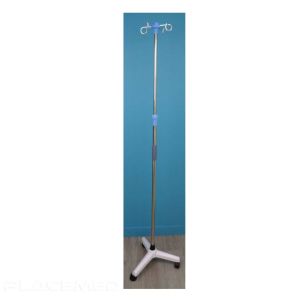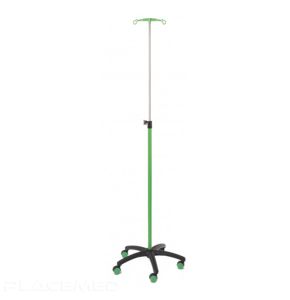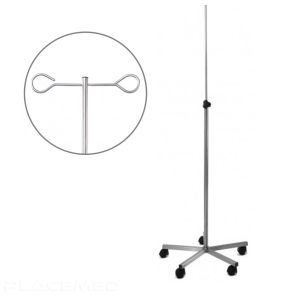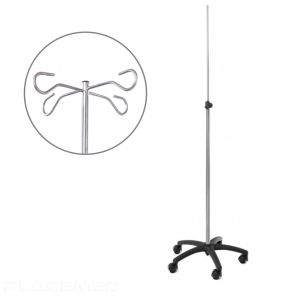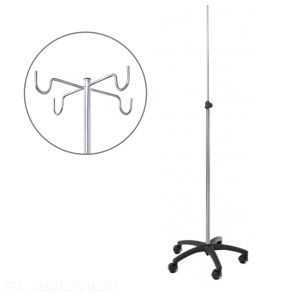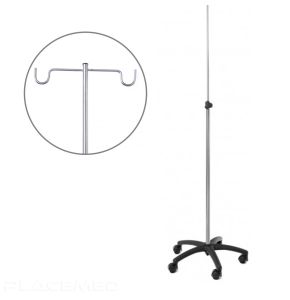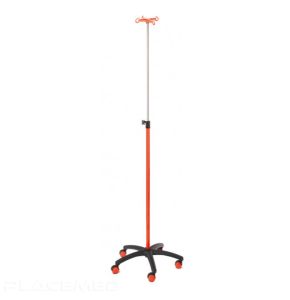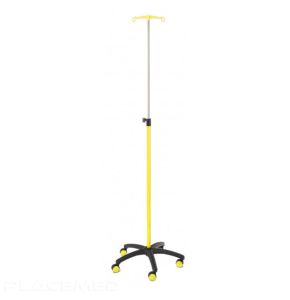IV Pole
3760223830606 18/11/2024 37
18/11/2024 39
18/11/2024 37
3661040168197 18/11/2024 33
3760223834543 18/11/2024 28
18/11/2024 35
18/11/2024 44
18/11/2024 37
18/11/2024 36
18/11/2024 36
18/11/2024 39
18/11/2024 39
18/11/2024 39
18/11/2024 27
18/11/2024 36
18/11/2024 34
18/11/2024 43
18/11/2024 41
18/11/2024 33
18/11/2024 33
18/11/2024 37
IV Poles: An Indispensable Equipment for Quality Care
The IV pole is an essential tool in hospitals and clinics. It is used to administer intravenous infusions safely and effectively. Thanks to it, patients receive the medications and fluids they need. Its design directly influences patient comfort and the quality of care. At Placemed, we offer a wide range tailored to all needs. In this guide, we will explore the different types available, how to choose them, safety considerations, maintenance, and innovations that enhance patient care.
What are the different types of IV poles and their advantages?
There are several types, each with its own advantages. Here are the main models and their specific uses:
- Floor IV Poles: This is the most common model. It consists of a base with wheels and an adjustable-height rod. It allows multiple infusion bags to be hung. This model is easy to move and adapts to different situations. It is ideal for hospital wards where patients need to be mobile.
- Wall-Mounted IV Poles: Fixed to the wall, it frees up floor space. It is stable and reduces the risk of tripping over the pole's legs. This model is often used in operating rooms or rooms where space is limited.
- Mobile IV Poles: Equipped with high-quality wheels, it moves easily with the patient. It is practical for patients who need to move within the ward, for example, to go to the bathroom or walk down the corridor.
- Adjustable IV Poles: The height and tilt can be modified to suit the patient's needs. It offers great comfort and facilitates the work of healthcare staff. This model is useful for bedridden patients or those in wheelchairs.
- IV Poles with Accessories: Some models are equipped with mounts for infusion pumps, monitors, or other medical devices. They allow multiple pieces of equipment to be grouped on a single stand, simplifying management and movement.
Each type meets specific needs. The choice depends on the care environment and the patient's requirements.
How to choose an IV pole adapted to a particular clinical environment?
Choosing such equipment must take into account several criteria to ensure effective and safe use. Here are the main elements to consider:
- Stability: A stable support prevents falls and accidents. It should have a solid base, often star-shaped, to evenly distribute the weight. The wheels must be of good quality and equipped with brakes to immobilize the stand when necessary.
- Mobility: If the patient needs to move, a mobile model with smooth wheels is essential. It should be easy to push and steer, even in confined spaces. Swivel wheels facilitate maneuvering.
- Ease of Use: The stand should be simple to adjust. The height should be easily adjustable, with a secure mechanism. Hooks for hanging bags should be accessible and sturdy.
- Number of Hooks: Depending on the needs, it may be useful to have multiple hooks to hang several infusions simultaneously. Some models offer up to six hooks.
- Materials: Materials should be durable and easy to clean. Stainless steel is commonly used for its durability and corrosion resistance.
- Compatibility with Equipment: If you use infusion pumps or other devices, ensure that the stand is compatible and can safely accommodate them.
By considering these criteria, you can choose the model that best fits your clinical environment, thereby improving the quality of care.
What are the safety considerations when using an IV pole?
Safety is paramount when using it. Here are the points to monitor to prevent accidents:
- Fall Prevention: Ensure it is stable and that the wheel brakes are engaged when the patient is stationary. Avoid overloading the stand with too much weight at the top, which could make it unstable.
- Cable Management: Tubes and cables should be well-organized to prevent them from tangling or dragging on the floor. Use ties or guides to keep them in place.
- Proper Positioning: Place it at an appropriate distance from the patient so that it is accessible without hindering movement. Avoid blocking passages or access to essential equipment.
- Regular Inspection: Regularly check its condition. Ensure that the wheels function correctly, the brakes hold well, and the hooks are in good condition.
- Staff Training: Healthcare staff must be trained in its correct use, including adjustments and safety measures.
By adhering to these guidelines, you ensure the safety of both the patient and the staff while ensuring effective administration of infusions.
How to properly maintain and disinfect IV poles?
Regular maintenance is essential to ensure their proper functioning and prevent infections. Here are the steps to follow:
Cleaning Protocols
Clean it with a soft cloth and a suitable detergent to remove dirt and residues. Then, disinfect the surfaces with a product approved for medical equipment. Be sure to follow the manufacturer's instructions for contact time and rinsing.
Materials Resistant to Disinfectants
They must be made of materials that withstand cleaning and disinfecting products. Stainless steel and medical-grade plastics are ideal as they do not degrade over time.
Component Inspection
Regularly check movable parts, such as wheels and height adjustment mechanisms. Immediately replace any damaged or worn parts to prevent accidents.
Maintenance Logging
Keep a record of cleaning and maintenance operations. This allows tracking the history and planning preventive maintenance.
Regular maintenance prolongs its lifespan and ensures a safe environment for patients and staff.
What innovations exist in IV poles to improve patient care?
These devices have evolved to integrate advanced technologies that enhance care. Here are some of the recent innovations:
- Integration of Infusion Pumps: Some models are designed to accommodate electronic infusion pumps. This allows precise administration of medications and fluids, with easy adjustments for healthcare staff.
- Smart Devices: Equipped with sensors and communication systems, these devices can monitor infusions in real-time. They can send alerts in case of problems, such as an obstruction or the end of the infusion.
- Improved Ergonomics: New designs are lighter and easier to maneuver. Height adjustments are simplified, often with one-handed systems, to facilitate staff work.
- Customization: Some models offer customizable options, such as additional trays, mounts for monitors, or integrated electrical outlets. This allows the stand to be adapted to the specific needs of the ward.
- Innovative Materials: The use of antibacterial or easy-to-clean materials reduces the risk of nosocomial infections. Additionally, lighter materials improve the stand's mobility.
These innovations contribute to improving the quality of care and patient comfort while making the work of healthcare staff easier.
In conclusion, the IV pole is indispensable for ensuring quality care. Choosing the appropriate model, using it safely, and performing regular maintenance are essential to maximize its benefits. At Placemed, we offer a wide range of IV poles that meet the strictest standards. We are committed to providing equipment that enhances patients' lives and the work of healthcare professionals. Feel free to contact us to find the model that best suits your needs.
 Francais
Francais 
